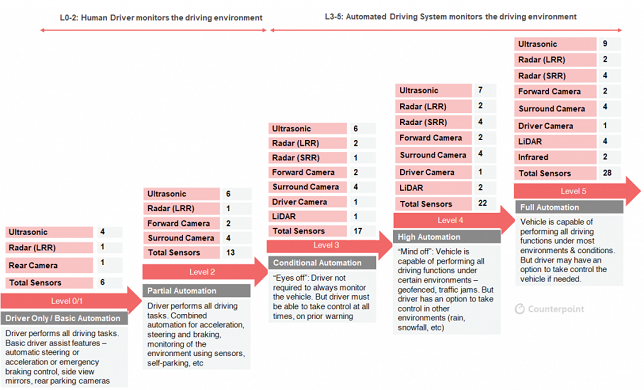Autonomous Vehicles to Boost Memory Requirement

Automotive innovation has majorly been in hardware during the last two decades. For instance, the efficiency of internal combustion engine has considerably increased during this time. However, during the last few years, the focus of automotive industry has shifted towards digitalisation, automation and electrification. The cars of the future will be electric, connected and autonomous. They will continuously accumulate, process and share data received from sensors and infotainment systems. By 2025, we expect, around 30% of cars sold globally will support Level 2 or above automation.
Advanced Driver Assistance Systems (ADAS) having multiple sensors will form the foundation of autonomous vehicles (AVs). The exhibit below highlights the increasing number of advanced sensors required for the goal of achieving highly or fully-automated driving.
Vehicles will be increasingly designed to gather, process and store data locally as well as selectively upload data at an appropriate time. This will create a need for data storage and computing infrastructure within the car, as well as in the cloud.
How Much Data Will AVs Generate?
AVs will generate huge amounts of data, not all of which will be stored in the vehicle. Some of it will be discarded or transferred to cloud. It is difficult to accurately gauge the amount of data generated by an AV. Data generated by a sensor depends on its application and specifications. For instance, data generated by a front camera could range between 70 GB/hr and 300 GB/hr depending on its resolution, color depth, frame rate and compression levels.
The amount of data generated by an AV will also depend on the type of vehicle. For instance, robo-taxis and OEM test vehicles, which are less sensitive to hardware costs when compared to passenger vehicles, will generate more data. A typical OEM test vehicle will generate around 80% more data when compared to a passenger car of same autonomy level. With more than 20 different types of sensors that can be integrated into a Level 4 AV’s ADAS, the vehicle can generate data in the range of 1-2TB/hr, depending on whether it is a passenger vehicle, commercial vehicle, or a robo-taxi.
Key Applications Using Data
While sensors will be the primary data source in AVs, there are many other applications which will consume data. Moreover, different entities within the vehicle ecosystem as well as smart city will likely use the data generated by all such vehicles.
Some of the key applications using data are explained in detail below:
Sensors
Sensors will account for the largest share of a vehicle’s on-board storage data. Sensor data will mostly come from ADAS systems and V2X capabilities.
AV Platform, Infotainment, OS and Applications
The AV platform is required to run various autonomous/ADAS features that drive additional storage needs for an advanced operating system (OS), voice AI applications, productivity, and other offline content.
With improving safety regulations, a black box for recording the most recent information is expected to become a mandatory requirement. Data generated from connected and safety services, OTA updates, and similar services will also require some additional local storage space.
HD Maps
Unlike the 2D maps used in current cars, the high-precision (HD) maps of AVs vary a lot in terms of frequency of refresh rates and sampling methods. HD maps will wirelessly have real-time updates to accurately drive the AV with precision and safety.
HD maps are so accurate that they can complement some of the sensor deficiencies to increase positional accuracy. Current 2D maps have only a static layer which can be updated once a month. However, HD maps have a static layer, semi-static layer, semi-dynamic layer and a dynamic layer. HD maps are updated every hour, minute and second.

Data Storage Strategies for Automakers
Today, automakers prefer to store the data locally as the amount of data generated by the car is relatively modest. But as they move to autonomy Levels 4-5, a combination of cloud and edge computing strategies will prevail. Automakers will not rely entirely on cellular networks due to the following challenges:
- Large size of data sets
- Requirement of high-speed and real-time processing
- High bandwidth costs
- Security and privacy issues
The cost of transmitting the data to the network will become a deciding factor on how and what data is transmitted. For instance, the cost to transfer all the data from a Level 4-5 AV to the cloud for a single day could run into thousands of dollars for automakers. This is unlikely to be a viable solution across an entire fleet of cars, creating a huge opportunity for on-board storage.
Commercialisation of 5G networks can reduce the data latency to less than 10 milliseconds. However, 5G will take several years to roll out and have a broad coverage across the world. Till then, the systems will be based on 4G LTR networks. Therefore, on-board storage will be the best option for automakers to store data.
There are challenges at each stage of the data journey which warrant prudent data collection, storage and usage strategies. An AV will face design and cost limitations, whereas network and cloud will have limitations related to bandwidth, latency, security and connectivity. Therefore, an AV will need to have an intelligent storage and offload system.
Many new business models may emerge in future for offloading the data to cloud. The data can be offloaded at charging stations over an ethernet cable, or at service stations during routine car service. The data itself may be pared down to simpler metadata rather than raw unprocessed data streams depending on the need to for the type of data to train the models or enrich the database.
The business model for data management will vary depending on the usage of vehicle – passenger vehicles, commercial vehicles, robo-taxis and OEM test vehicles. For example, OEM test vehicles will have a larger share of data stored locally when compared to passenger vehicles. OEM test vehicles and commercial vehicles could regularly visit a base station for swapping of physical storage systems.
Opportunities for Storage Players
Embedded Multimedia Card (eMMC) storage is the most common way to store data from in-vehicle infotainment systems. However, eMMC cannot support future AVs, which will have sophisticated graphical user interfaces and will require high-speed access from memory. Moreover, there has to be more storage space in the infotainment system to store multimedia and high-resolution maps.
In the evolution of fully autonomous driving, signals from sensors are processed at a high speed by the drive computer, which requires high bandwidth. Besides, drive computers will likely include redundant systems running in parallel and comparing decision outcomes in real time, potentially multiplying memory requirements.
To cater to this exponential increase in storage with increasing autonomy levels, the storage technology needs to evolve from Single-Level Cell NAND (SLC NAND) to e.MMC/Universal Flash Storage (UFS) to embedded Solid-State Drive (SSD)
SLC NAND
- Applications: Event log in Event Data Recorder (EDR), code storage in embedded system, data storage in dashboard
- The capacity is small and needs to be managed by the system
- Widely used from Level 1 to Level 5 with a maximum capacity of 4GB
e.MMC/UFS
- Applications: Infotainment system, navigation system and code storage in ADAS
- MLC eMMC/UFS has been so far widely used in ADAS since it provides a good compromise between performance and cost, data security, durability, price and capacity
- Further, a move to 3D NAND (TLC) eMMC/UFS has helped from a cost perspective
- It will be used in Level 2 to Level 4
UFS/embedded SSD
- Applications: Storage of high-resolution maps, AV computer, AI database, black box data recorder
- Price of SSD is higher than other storage systems, but it can provide better speed, larger capacities and higher bandwidth
- It will be used in Level 3 to Level 5
Safety, reliability and quality are critical for automotive memory storage units. Automotive memory must, at a minimum, conform to these three standards – ISO26262, AEC-Q100 and IATF16949.
Author:

Aman Madhok is a Senior Analyst with Counterpoint Technology Market Research, based out of Gurgaon (near New Delhi). Aman started his market research career with GlobalData and has close to 10 years of work experience in this field. He led various research and consulting projects for multiple sectors from energy to automotive. He has a deep understanding of automotive industry helping clients to navigate through the rapidly changing trends.
Published in Telematics Wire



